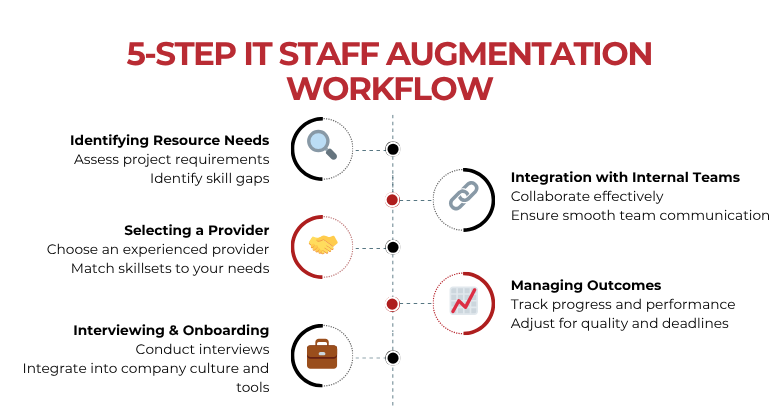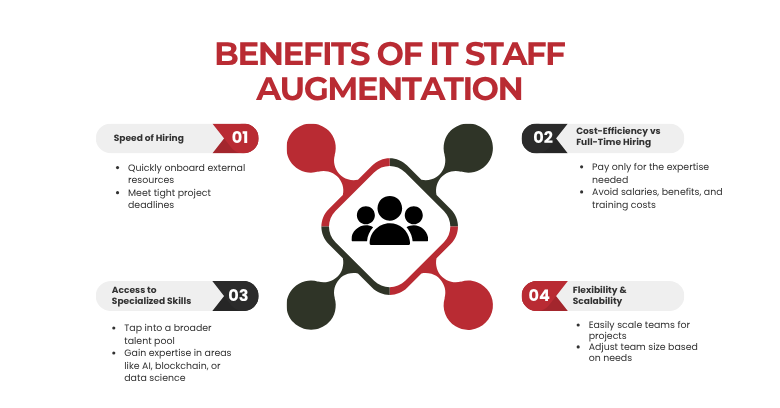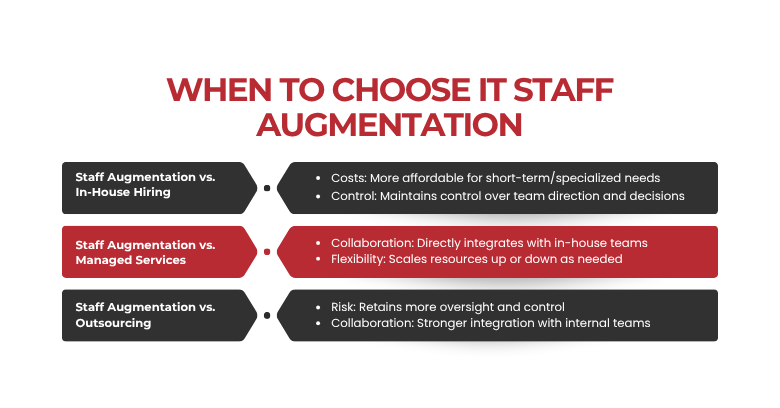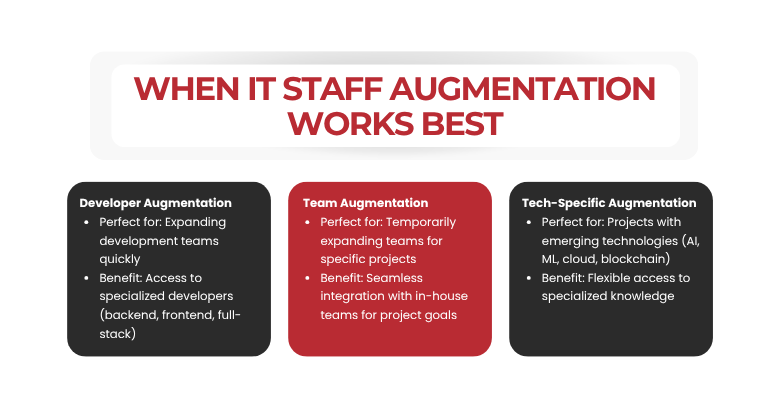In today’s fast-moving tech world, businesses need to adapt quickly, but challenges like finding the right talent and managing remote work can make this tough. That’s where IT staff augmentation comes in. But what is IT staff augmentation? It’s a flexible solution that lets companies bring in skilled professionals temporarily to fill critical gaps and meet project demands. Let’s dive in to see the real staff augmentation meaning and how this approach is transforming the way businesses operate.
Table of Contents
ToggleStaff Augmentation Meaning: Explained Simply
Staff augmentation meaning refers to the practice of adding temporary external resources to an in-house team to fill skill gaps or meet project demands. Instead of hiring full-time employees, businesses can bring in specialized talent for a specific period, offering flexibility and cost efficiency. This approach allows companies to scale their workforce quickly without the long-term commitment, ensuring that teams can stay agile and responsive to changing needs.
What Does Staff Augmentation Mean in IT?
Staff augmentation meaning in the IT industry, revolves around hiring external professionals to enhance an organization’s existing teams temporarily. Rather than hiring permanent employees or outsourcing entire projects, businesses turn to staff augmentation to bring in the right skills and expertise as needed.
Unlike full-time employment or outsourcing, staff augmentation allows businesses to maintain control over their internal processes while supplementing their teams with external talent. This makes it ideal for projects with a defined timeline or specific skill requirements, like developing a new software product, enhancing a website, or integrating a new system.
Staff augmentation is not about shifting responsibilities outside the organization. Instead, it’s about collaborating with external talent who work alongside your in-house team to achieve the project goals without the long-term commitment that comes with traditional hiring.
How Is It Different from Team or Resource Augmentation?
While staff augmentation is often used interchangeably with terms like team augmentation or resource augmentation, it’s essential to understand the subtle differences.
- Team augmentation refers to adding external professionals who integrate directly into your existing team, complementing their efforts without changing the overall team structure. This approach is ideal when a project requires additional manpower or specific expertise, such as technical staff augmentation for a software project.
- Resource augmentation, on the other hand, focuses more on bringing in additional resources or tools. For instance, if your team requires certain software or hardware for a project, resource augmentation may cover those needs.
Both terms overlap, but staff augmentation tends to focus specifically on hiring external human resources to fill specific roles within a team, whereas team and resource augmentation can refer to adding people, tools, or technology.
For a comprehensive look at workforce and learning trends shaping the future of work, explore CompTIA’s Workforce and Learning Trends 2024 report.
| Need Specialized Talent Fast? Let’s Talk. If you’re grappling with tight deadlines or skill shortages, our team is ready to help you scale quickly and efficiently. Reach out now to discuss how we can support your next project. 👉 Contact Us Today |
How Does IT Staff Augmentation Work? A Step-by-Step Process
The staff augmentation process is generally straightforward, with clear steps to ensure smooth integration and collaboration between in-house teams and external resources.
A Typical 5-Step Workflow:

- Identifying Resource Needs: The first step is determining which roles or skills are required. This might involve identifying knowledge gaps or assessing project demands. For example, you may need a developer staff augmentation to handle a specific coding task or a technical expert to optimize your IT infrastructure.
- Selecting a Provider: Once the needs are clear, the next step is selecting a staff augmentation provider. Providers offer a pool of candidates with the required skill set, so choosing one with experience in your domain—like software staff augmentation—is crucial.
- Interviewing and Onboarding: Once candidates are shortlisted, businesses conduct interviews to ensure they’re a good fit. Onboarding includes familiarizing them with the company culture, tools, and processes. External resources are integrated into the team as if they were internal employees.
- Integration with Internal Teams: The hired professionals begin working alongside your in-house team. Effective communication and collaboration are key to ensuring seamless integration. External staff members bring fresh perspectives while adapting to the team’s workflow.
- Managing Outcomes: The final step is managing the external team to ensure they’re meeting goals, deadlines, and quality standards. Regular performance reviews help track progress and make any necessary adjustments.
Common Engagement Models
When engaging in staff augmentation, businesses can choose from several models, depending on the nature of their project or requirements:
- Fixed-term: A set duration for completing specific tasks or projects. This model is typically used when you need additional resources for a clearly defined timeline.
- Project-based: In this model, resources are brought in for the entire length of the project, from inception to completion.
- Time & Material: This model is ideal when the exact scope of the project is uncertain. You pay based on the hours worked and materials used, providing flexibility for changes as the project progresses.
For example, a developer-based augmentation model might involve bringing in external developers for a fixed-term project that requires specific coding expertise, while a software staff augmentation model could be used for a broader software development project requiring multiple technical skills.
Looking for workforce trends? The 2023 Stack Overflow Developer Survey provides insights into the latest tech talent and industry trends.
Real-World Use Cases and Examples
Staff augmentation is an incredibly versatile solution. Here are a few real-world staff augmentation examples of how organizations leverage it:
- Startups Needing Quick Scale: Startups often face limited resources and must scale quickly to meet market demands. Staff augmentation services allow them to hire specialized talent temporarily without going through the lengthy recruitment process. For more on how we help businesses like yours, visit our IT Staff Augmentation Services.
- Enterprises Filling Niche Skill Gaps: Large enterprises often require niche technical skills for specific projects. Instead of hiring permanent staff, they turn to technical augmentation to find experts in areas like cybersecurity, cloud computing, or artificial intelligence.
- Agencies Handling Client Overflow: Digital marketing or development agencies often face project surges. Instead of overburdening their existing teams, agencies can use staff augmentation model to temporarily add developers, designers, or project managers to manage the increased workload.
Benefits of IT Staff Augmentation
The benefits of staff augmentation are numerous, and companies across industries have found it to be an effective strategy for scaling their teams quickly and efficiently. Here are some of the key advantages:

- Speed of Hiring: The process of hiring full-time employees can be time-consuming. With staff augmentation, companies can bring in external resources almost immediately, helping them meet tight deadlines and project requirements.
- Access to Specialized Skills: Staff augmentation allows businesses to tap into a broader talent pool and access specialized skills without the need for permanent hires. This is particularly beneficial for tech companies that require highly specialized expertise, such as AI, blockchain, or data science.
- Cost-Efficiency vs Full-Time Hiring: Hiring full-time employees comes with significant costs, including salaries, benefits, and training. Staff augmentation process allows businesses to pay only for the specific expertise they need, which can be more cost-effective for short-term or specialized projects.
- Flexibility and Scalability: Whether a business needs to scale up quickly for a product launch or scale down after a project is completed, staff augmentation offers the flexibility to adjust team size as needed, making it an excellent solution for dynamic business environments.
Highly-skilled professionals are increasingly looking for flexibility rather than full-time positions. To learn more, read this article on how highly-skilled professionals want your work but not your job.
When Should You Choose Staff Augmentation Over Other Models?
Understanding when to choose staff augmentation over other staffing models can help businesses make the right decision. Here’s how it compares to other models:

Staff Augmentation vs. In-House Hiring
- Costs: Full-time hires can be more expensive due to salaries, benefits, and long-term commitments. Staff augmentation provides a more affordable solution for short-term needs or specialized projects.
- Control: With staff augmentation, businesses maintain control over the team’s direction and decision-making. In contrast, outsourcing can result in a loss of control over certain project aspects.
Staff Augmentation vs. Managed Services
- Collaboration: Staff augmentation allows external resources to work directly with in-house teams, fostering closer collaboration. Managed services, however, often operate more independently and can take control of specific tasks.
- Flexibility: Staff augmentation offers more flexibility as businesses can scale resources up or down as needed. Managed services, on the other hand, are often more rigid in their engagement terms.
Staff Augmentation vs. Outsourcing
- Risk: Outsourcing involves delegating full responsibility for a project or process to an external company, which can carry more risk in terms of control and quality. Staff augmentation helps businesses retain more oversight while still bringing in outside expertise.
- Collaboration: With staff augmentation, external professionals are more integrated with the internal team, leading to better communication and collaboration.
For a comprehensive comparison of IT staff augmentation models, check out our comprehensive guide on IT Staff Augmentation.
If you’re looking for more options, check out our detailed list of Top 10 IT Staff Augmentation Companies for more insights on this growing industry.
Is Staff Augmentation the Right Choice for You?
Wondering if staff augmentation is the right fit for your business? Here’s a comprehensive checklist to help you determine if this staffing model aligns with your organization’s needs and goals.
1. Company Size:
Staff augmentation is versatile and can benefit businesses of any size. Whether you’re a startup needing to scale quickly or a large enterprise filling skill gaps for a specific project, staffing augmentation can provide the flexibility to meet your workforce demands without the burden of long-term commitments.
- Startups: Quick access to specialized talent for product launches or time-sensitive projects without hiring full-time employees.
- Small to Medium Businesses (SMBs): Cost-effective solutions for expanding teams on-demand and addressing skill shortages.
- Large Enterprises: Efficiently managing high-scale projects with access to top-tier professionals without disrupting your core team.
2. Project Type:
If your project requires specialized skills, extra resources, or the ability to scale quickly, staff augmentation could be your ideal solution. It’s particularly beneficial for projects that require specific expertise for a limited time or scope.
- Short-Term Projects: Add specific talent to meet tight deadlines or project milestones.
- Specialized Tasks: Bring in experts for niche areas such as cybersecurity, AI, or blockchain without having to hire full-time staff.
- Overflow Work: Manage increased workloads from existing projects without stretching your core team.
3. Tech Maturity:
If your organization operates in a highly technical domain and requires cutting-edge skills or expertise, staff augmentation can be an effective way to gain access to top professionals quickly. This approach works well for businesses that need to ramp up for a specific project or technology upgrade, such as adopting new software or upgrading infrastructure.
- Innovation: For companies diving into emerging technologies like machine learning or AI, technical staff augmentation can provide the specific talent needed for rapid development.
- Expertise: If your team lacks the knowledge or skills required for a new technology stack, developer staff augmentation or software staff augmentation can fill the gap.
- Speed: Quickly adapt to new trends, technologies, and projects without long recruitment cycles.
4. Budget Flexibility:
If budget constraints are a concern but you still need specialized talent, staff augmentation offers a more cost-effective solution compared to hiring full-time employees. You can hire experts for specific projects without the long-term financial commitment of full-time staff, helping you allocate resources to other critical areas of the business.
- Pay as You Go: Only pay for the time and resources needed for the project.
- Avoid Overhead Costs: No need to invest in recruiting, benefits, training, or other overhead associated with permanent employees.
5. Scalability:
When your business is scaling up or down rapidly, staff augmentation offers a high level of flexibility. You can easily add professionals when demand peaks and reduce the workforce when the project or need is over.
- Temporary Surge: When your team is short on resources due to increased work demands, staff augmentation services provide the needed support without long-term hiring commitments.
- Adapt to Market Changes: Easily adjust your workforce to accommodate new projects, client needs, or business directions.
For insights into how generative AI is transforming the staff augmentation industry, check out this Gartner report on the impact of Generative Artificial Intelligence on Staff Augmentation.
Upwork is expanding its corporate staffing capabilities beyond freelancers. Learn more about their acquisitions of Bubty and Ascen in this TechCrunch article.
When It Works Best

- Developer Augmentation: This model works perfectly for software development teams that need to quickly expand with extra developers for short-term projects. Whether you need backend, frontend, or full-stack developers, developer staff augmentation allows you to bring in the right skill set without the hassle of permanent hiring.
- Team Augmentation: This is an excellent option for organizations that need to expand their team temporarily for a specific project or task. With team augmentation, you can bring in a group of experts who seamlessly integrate with your in-house team to meet project goals or handle client overflow.
- Tech-Specific Augmentation: If your business is working with new or evolving technologies such as artificial intelligence, machine learning, cloud computing, or blockchain, staff augmentation offers a flexible way to bring in the specialized knowledge required for these projects.
Why Choose Staff Augmentation?
If your company needs flexibility, speed, and access to specialized talent, staff augmentation is likely the right choice. Whether you’re managing a short-term project, filling a skill gap, or scaling your team without the hassle of permanent hires, staff augmentation offers a streamlined solution for your business needs.
- Faster Execution: Quickly address skill gaps, meet project deadlines, and scale your team efficiently.
- Resource Optimization: Bring in the right talent for the right time and project, optimizing your workforce for maximum productivity.
- Long-Term Cost Savings: Avoid the costs associated with full-time hires and ensure that your team stays flexible and adaptable.
If you’re interested in overcoming challenges when hiring tech talent, this McKinsey article on overcoming the fear factor in hiring tech talent offers valuable tips.
Discover how Toptal connects businesses with the top 3% of freelance talent across various domains, including software development, design, and project management. Visit Toptal to learn more.
Conclusion:
In conclusion, staff augmentation is an invaluable solution for businesses looking to scale their teams quickly, gain specialized skills, and maintain flexibility. Whether you’re a startup in need of extra development resources or an enterprise looking to fill niche skill gaps, staff augmentation offers an agile, cost-effective solution that can help you meet your goals efficiently. Learn more about Geeks of Kolachi and our innovative solutions by visiting our website.
| Ready to Bridge Your Skill Gaps? We’re Here to Assist. Whether you’re a startup aiming to scale or an enterprise tackling a complex project, our staff augmentation services can provide the expertise you need. Connect with us to find the right fit for your team. 👉 Get in Touch Now |
Frequently Asked Questions
What is staff augmentation in IT?
Staff augmentation in IT is a hiring strategy where businesses temporarily add external professionals to their in-house team. Instead of hiring full-time employees, companies bring in skilled contractors to fill skill gaps or support project demands—while maintaining control over the project and workflow.
What’s the difference between staff augmentation, outsourcing, and managed services?
Staff augmentation differs in how control and responsibility are managed:
1. Staff Augmentation: You manage the project. External staff work under your direction.
2. Outsourcing: You delegate an entire project to a third-party vendor.
3. Managed Services: You hand off ongoing operations to a vendor who manages the process independently.
When should a company use staff augmentation?
Use staff augmentation when:
1. You need to fill short-term or specialized skill gaps
2. Projects have tight deadlines or sudden scope changes
3. You’re scaling quickly and want to avoid long recruitment cycles
4. You need flexibility without long-term hiring commitments
What roles can staff augmentation cover in IT?
Common roles filled through IT staff augmentation include:
Software developers (frontend, backend, full-stack)
QA testers and automation engineers
DevOps and cloud specialists
AI, data science, and cybersecurity experts
UI/UX designers and product managers
What are the engagement models for staff augmentation?
There are three main staff augmentation models:
1. Fixed-Term: Staff work for a defined period.
2. Project-Based: Staff stay for the duration of a specific project.
3. Time & Material: Flexible billing based on hours worked and resources used.
How much does IT staff augmentation cost?
IT staff augmentation costs depend on the skill level, region, and engagement model.
On average:
Junior to Mid-Level Developers: $25–$70/hour
Senior Engineers / Specialists: $80–$150+/hour
This is often more cost-effective than full-time hiring due to lower overhead.
How do I choose the best staff augmentation provider?
Look for a provider with:
1. Proven expertise in your industry or tech stack
2. A vetted talent pool with certifications or portfolios
3. Flexible contract and engagement models
4. Clear onboarding, communication, and support process
5. Client testimonials and case studies
How fast can I onboard augmented staff?
In most cases, you can onboard augmented staff within 3 to 10 business days.
The process is faster than traditional hiring because the talent is pre-vetted and ready to start immediately.
What are the risks of staff augmentation, and how can I reduce them?
Common risks include:
1. Miscommunication between teams
2. Poor cultural fit or misaligned expectations
3. Onboarding delays or lack of process
To mitigate risks:
1. Choose experienced providers with proven processes
2. Establish clear communication channels and KPIs
3. Use agile workflows and collaborative tools
How do I integrate augmented staff with my internal team?
To integrate staff augmentation talent effectively:
1. Use onboarding checklists and knowledge-sharing tools
2. Assign a team lead or mentor internally
3. Involve them in stand-ups and planning meetings
4. Set clear goals, feedback loops, and shared KPIs
